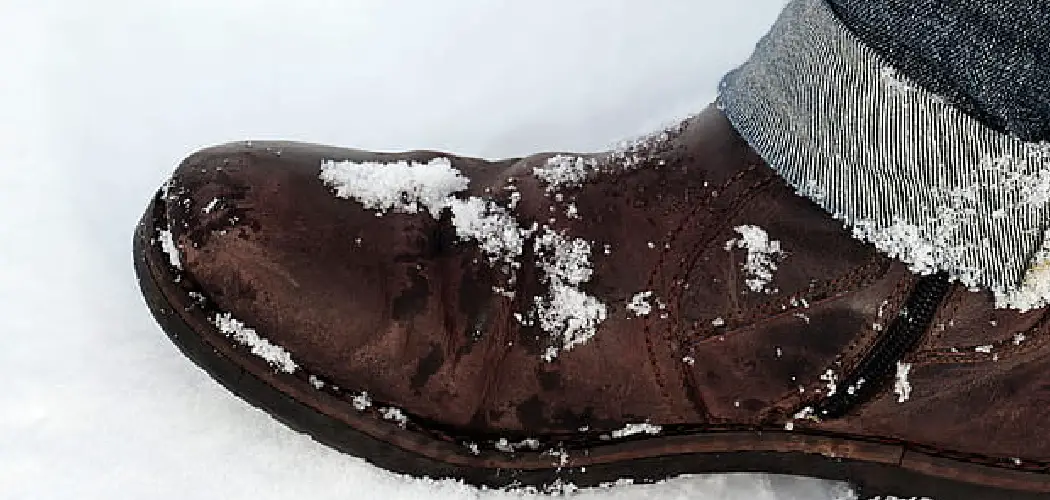Are you tired of your Ugg boots being ruined by salt stains during winter?
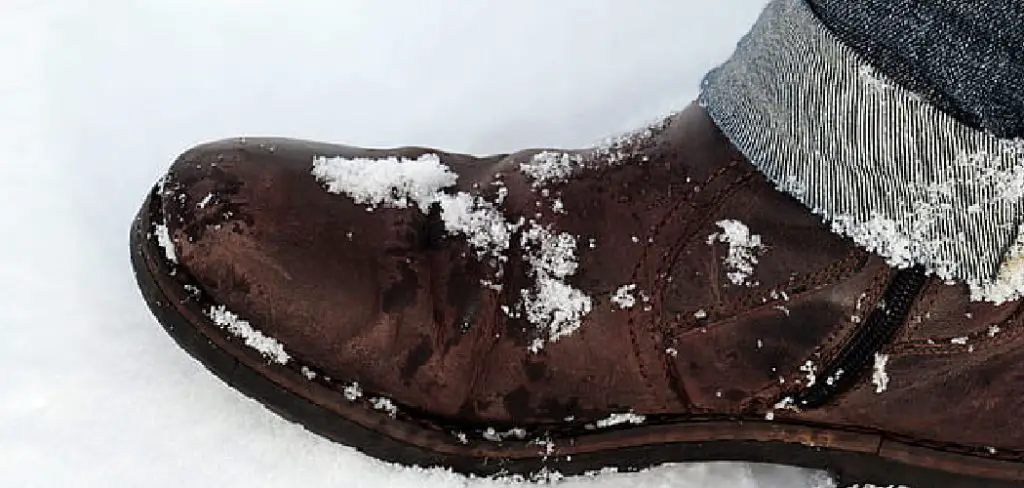
Ugg boots are beloved footwear for their warmth and comfort, especially during the colder months. However, when winter weather brings snow and ice, it also brings salt on sidewalks and roads, leading to unsightly stains on your cherished boots. Salt can cause damage to the suede material of Ugg boots if not removed promptly, leaving behind white marks and potentially drying out the fabric.
Luckily, there are effective methods to clean and restore your Uggs to their original beauty. In this guide, we’ll walk you through step-by-step instructions on how to get salt off of ugg boots, ensuring they remain cozy and stylish all season long.
What Will You Need?
First and foremost, you’ll need the following supplies to remove salt stains from your Ugg boots effectively:
- A soft-bristled brush or toothbrush
- White vinegar or rubbing alcohol
- Distilled water
- Suede protector spray (optional)
It’s important to note that these methods are specifically for cleaning salt stains on suede Ugg boots. If you have leather or sheepskin Uggs, you should take them to a professional cleaner for proper care.
10 Easy Steps on How to Get Salt Off of Ugg Boots
Step 1: Brush Off Excess Salt
Before you begin the cleaning process, gently brush off any loose salt from the surface of your boots using a soft-bristled brush or an old toothbrush. This step is crucial as it helps to remove the initial layer of dry salt, preventing it from being further embedded into the suede material.
Carefully sweep the brush across the surface toward the nap, avoiding excessive pressure to preserve the texture and integrity of the suede. Take extra care around seams and crevices where salt often accumulates. Doing this initial cleaning makes the following steps more effective in tackling the deeply ingrained salt stains.
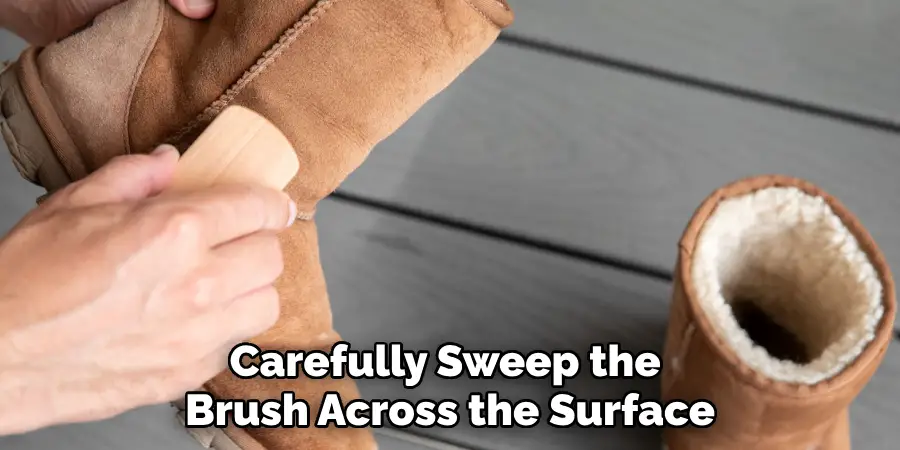
Step 2: Prepare a Cleaning Solution
Mix equal parts of white vinegar and distilled water in a small bowl. This solution will help break down the salt without causing damage to the suede. If you prefer, you can substitute rubbing alcohol for vinegar, which removes salt stains effectively.
Once mixed, dip a clean cloth into the solution, ensuring it is damp but not overly saturated, to prevent excess moisture from soaking into the boots. Remember, using distilled water is essential because tap water can contain minerals that may leave additional stains or cause further staining on the suede.
Step 3: Apply the Cleaning Solution
Begin applying the cleaning solution to the stained areas of your Ugg boots. Use the dampened cloth and gently blot the solution onto the suede, focusing on each salt stain. Avoid rubbing vigorously, as this can further damage the delicate material.
Carefully work the solution into the stains by using gentle, circular motions, allowing the mixture to penetrate the suede fibers. The vinegar or rubbing alcohol should loosen the salt deposits effectively, while the distilled water aids in lifting them without leaving any harsh residues.
Take time with this process to treat each stained section adequately. If needed, re-dampen the cloth with the solution to keep it effective, but be mindful of using too much liquid, which could saturate and distort the suede structure. It’s crucial to address all visible stains to prevent the salt from causing lasting discoloration or damage.
Step 4: Blot the Treated Area
Once you’ve applied the cleaning solution to all the stained parts, take a clean, dry cloth and blot the treated area gently. This will help absorb excess moisture and lift the loosened salt particles away from the suede. It’s essential to use a blotting technique rather than wiping; pressing the cloth into the suede will prevent spreading any remaining salt.
Be thorough yet gentle to maintain the texture of the suede. Keep blotting until the surface feels only slightly damp and you can no longer see visible salt residue being lifted with each press. This drying step is critical to ensure the suede dries evenly without any new marks.
Step 5: Allow the Boots to Air Dry
After blotting the treated areas, letting your Ugg boots air dry naturally is crucial. Place them in a well-ventilated area at room temperature, away from direct heat sources such as radiators or sunlight, which can harden and crack the suede. Letting the boots dry slowly ensures the material remains soft and pliable, maintaining comfort and appearance.
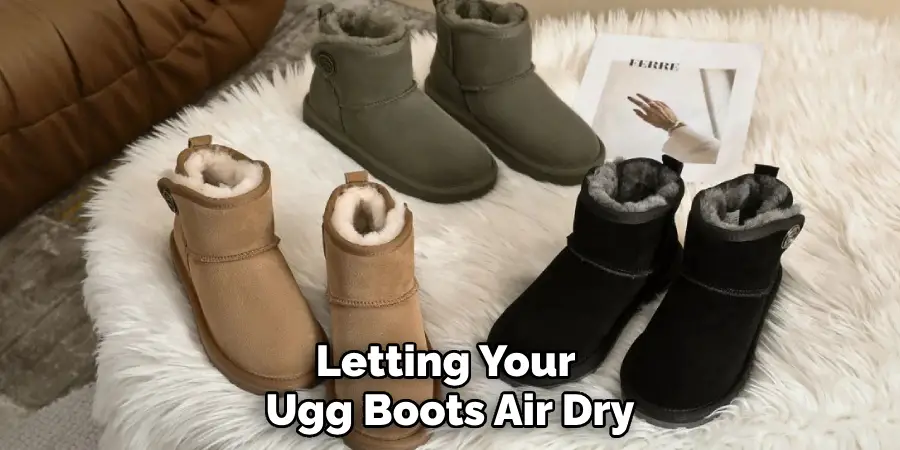
This process can take several hours, depending on the humidity, so patience is critical. Make sure the boots are upright, maintaining their shape throughout the drying process. Avoid wearing them until they are scorched to prevent any new creases or marks from forming.
Step 6: Brush the Suede
Once the boots are completely dry, use a suede brush to restore the nap and texture of the material. Gently brush the surface in the direction of the nap, which will help fluff up any matted areas and make your Ugg boots look as good as new. Brush softly, particularly around seams and high-wear regions, to prevent potential damage to the suede.
This step not only enhances the aesthetic of the boots but also ensures they maintain their soft, cozy feel. If you notice any areas that still appear stiff or discolored, you may need to repeat the cleaning process for those specific spots.
Step 7: Apply Suede Protector Spray (Optional)
Consider applying a suede protector spray further to protect your Ugg boots from future salt stains and enhance their longevity. This step is optional but highly recommended, especially during harsh weather conditions when exposure to salt and moisture is frequent.
Before applying the spray, ensure that your boots are completely dry and have been brushed to restore the nap. Hold the spray can approximately 6-8 inches away from the boot and apply an even coat over the entire surface. Be sure to work in a well-ventilated area to avoid inhaling fumes.
Allow the spray to dry completely before wearing the boots again, as this will give the protector time to set and form an effective barrier against moisture and stains. Regularly applying the suede protector, according to the manufacturer’s instructions, will maintain the boots’ condition and keep them pristine throughout the season.
Step 8: Store Your Boots Properly
Proper storage is essential for maintaining the quality of your Ugg boots, especially once they’ve been cleaned and treated. Make sure they are scorched and free from any dirt or residues before putting them away. Store them in a cool, dry place, ideally in a fabric bag that allows them to breathe away from direct sunlight and moisture.
Avoid using airtight plastic bags, as they can trap humidity and cause deterioration. If your boots have specific shaping inserts, use them to help retain their shape while in storage. This step will extend the life of your shoes, keeping them ready for the next year without any unpleasant surprises.
Step 9: Regular Maintenance
To keep your Ugg boots looking their best and to prolong their lifespan, integrate regular maintenance into your routine care. Gently brush the suede with a dedicated brush after each wear to remove any dust or dirt that may have settled on the surface.
This simple action prevents grime from accumulating and becoming embedded in the material over time. Additionally, the boots should be inspected for any new stains or marks after each use, promptly addressing them using the earlier cleaning methods.

Step 10: Replace Insoles When Necessary
Over time, the insoles of your Ugg boots may compress or become worn due to regular use. Replacing them as needed can dramatically enhance the comfort and fit of your shoes. Look for high-quality replacement insoles specifically designed for your Ugg boots to ensure a proper fit and support.
When inserting new insoles, make sure they lay flat and do not fold or bunch up, as this can cause discomfort while wearing. Regularly freshening up your insoles will maintain the comfort of your boots and contribute to better foot hygiene.
By following these steps, you can effectively clean and maintain your Ugg boots, ensuring they look and feel as good as new for many seasons.
5 Things You Should Avoid
- Using Harsh Chemicals: Avoid applying harsh household cleaners or bleach on your Ugg boots. These chemicals can strip the natural oils from the suede, leading to discoloration and a dry, cracked texture. Always opt for products designed specifically for suede care.
- Applying Excessive Water: While cleaning salt stains, be cautious not to saturate the boots with water. Excessive moisture can seep into the material and cause it to lose shape or develop watermarks. It’s best to use damp, not soaking wet clothes and tools.
- Using Direct Heat to Dry: Never place your Ugg boots near direct heat sources such as heaters or radiators to speed up drying. High heat can harden and shrink the suede, ruining the texture and fit of the boots. Allow them to air dry naturally.
- Scrubbing the Suede Surface: Avoid aggressive scrubbing when removing salt stains or dirt. This can damage the delicate suede fibers and create bald spots. Instead, use gentle blotting and brushing techniques to preserve the material.
- Ignoring Stains: Pay attention to salt stains for a short time. Left untreated, they can be more difficult to remove and lead to permanent damage. Address stains promptly to maintain the appearance and integrity of your boots.
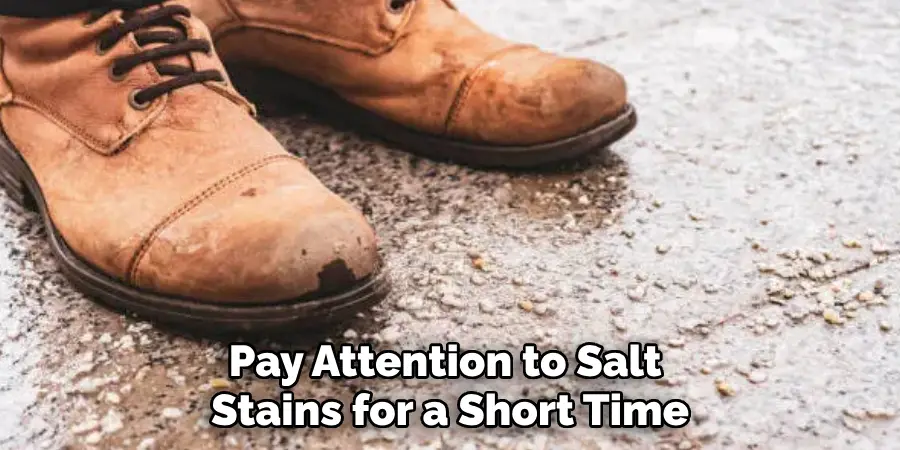
Conclusion
By adhering to these best practices and preventative measures, you can effectively manage and eliminate salt stains from your Ugg boots, preserving their beauty and functionality.
Understanding the nuances of how to get salt off of ugg boots is essential, from using the right products to ensuring proper drying techniques.
Regular maintenance and timely intervention play pivotal roles in preventing the accumulation of stains and damage. With careful attention and a dedicated cleaning routine, your Ugg boots can remain a staple in your wardrobe, unscathed by the harsh conditions of winter.
A little effort goes a long way in extending the life and maintaining the pristine appearance of your cherished footwear.

